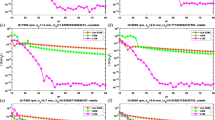Abstract
The stability of milling process dominated by multiple modes was traditionally predicted in the time domain by only selecting the most flexible mode. This paper theoretically studies the construction mechanism of stability lobes by simultaneously considering all dominant modes and provides an efficient method to predict stability lobes of milling systems with multiple modes in the time domain. It is theoretically proved that the effective stability lobes of milling system with multiple modes is made up of the lowest envelop of the stability lobes achieved with each single mode; hence, lowest envelop method (LEM) is established to predict the ultimate stability lobe by taking the lowest envelop of a group of stability lobes, which are calculated by separately considering different dominant modes composing the overall dynamic compliance. Typical advantage of LEM lies in that the computation time and the memory usage required in stability prediction can be greatly reduced for time domain solution. Moreover, the accuracy of prediction can be increased, when the effects of multiple modes are taken into account instead of considering only the most flexible mode. Formulation of the dynamic milling process with multiple modes is derived in semi-discrete time domain by including the effects of multiple delays. A series of simulations and experiments demonstrate the high efficiency and validity of LEM.
Similar content being viewed by others
References
Altintas Y (2012) Manufacturing automation, 2nd edn. Cambridge University Press, UK
Tobias SA (1965) Machine tool vibration. Blackie and Sons Ltd, New York
Altintas Y, Budak E (1995) Analytical prediction of stability lobes in milling. Trans ASME J Eng Ind 44:357–362
Bravo U, Altuzarra O, Lacalle LNL, Sanchez JA, Campa FJ (2005) Stability limits of milling considering the flexibility of the workpiece and the machine. Int J Mach Tools Manuf 45(15):1669–1680
Wang MH, Gao L, Zheng YH (2014) Prediction of regenerative chatter in the high-speed vertical milling of thin-walled workpiece made of titanium alloy. Int J Adv Manuf Technol 72:707–716
Tang AJ, Liu ZQ (2009) Three-dimensional stability lobe and maximum material removal rate in end milling of thin-walled plate. Int J Adv Manuf Technol 43:33–39
Budak E, Altintas Y (1998) Analytical prediction of chatter stability in milling—part I: general formulation. Trans ASME J Dyn Syst Meas Control 120(1):22–30
Mann BP, Bayly PV, Davies MA, Halley JE (2004) Limit cycles, bifurcations, and accuracy of the milling process. J Sound Vib 277(1–2):31–48
Insperger T, Stepan G (2004) Updated semi-discretization method for periodic delay-differential equations with discrete delay. Int J Numer Methods Eng 61:117–141
Wan M, Zhang WH, Dang JW, Yang Y (2010) A unified stability prediction method for milling process with multiple delays. Int J Mach Tools Manuf 50(1):29–41
Wan M, Altintas Y (2014) Mechanics and dynamic of thread milling process. Int J Mach Tools Manuf 87:16–26
Wan M, Kilic ZM, Altintas Y (2015) Mechanics and dynamics of multi-functional tools. Trans ASME J Manuf Sci Eng 137(1):011019
Eksioglu C, Kilic ZM, Altintas Y (2012) Discrete-time prediction of chatter stability, cutting forces, and surface location errors in flexible milling system. Trans ASME J Manuf Sci Eng 134(6):061006
Ahmadi K, Ismail F (2011) Analytical and stability lobes including nonlinear process damping effect on machining chatter. Int J Mach Tools Manufacture 51(4):296–308
Seguy S, Insperger T, Arnaud L (2010) On the stability of high-speed milling with spindle speed variation. Int J Adv Manuf Technol 48:883–895
Ding Y, Zhu LM, Zhang XJ, Ding H (2010) A full-discretization method for prediction of milling stability. Int J Mach Tools Manuf 50:502–509
Guo Q, Sun YW, Jiang Y (2012) On the accurate calculation of milling stability limits using third-order full-discretization method. Int J Mach Tools Manuf 62:61–66
Liang XG, Yao ZQ, Luo L, Hu J (2013) An improved numerical integration method for predicting milling stability with varying time delay. Int J Adv Manuf Technol 68:1967–1976
Butcher EA, Ma H, Bueler E, Averina V (2004) Stability of time-periodic delay-differential equations via Chebyshev polynomials. Int J Numer Methods Eng 59(7):895–992
Afazov SM, Ratchev SM, Segal J, Popov AA (2012) Chatter modelling in micro-milling by considering process nonlinearities. Int J Mach Tools Manuf 56:28–38
Seguy S, Dessein G, Arnaud L (2008) Surface roughness variation of thin wall milling, related to modal interactions. Int J Mach Tools Manuf 48(3–4):261–274
Mann BP, Young KA, Schmitz TL, Dilley DN (2005) Simultaneous stability and surface location error predictions in milling. Trans ASME J Manuf Sci Eng 127(3):446–453
Grakisek J, Kalveram M, Insperger T, Weinert K, Stepan G, Govekar E, Grabec I (2005) On stability prediction for milling. Int J Mach Tools Manuf 45:769–781
Schmitz TL, Smith KS (2008) Machining dynamics. Springer, New York
Lakshmikantham V, Trigiante D (1988) Theory of difference equation. Numerical methods and applications. Academic, London
Kolmanovskii VB, Nosov VR (1986) Stability of functional differential equations. Academic, London
Altintas Y, Kilic ZM (2013) Generalized dynamic model of cutting operations. CIRP Annals-Manuf Technol 62:47–50
Zhao MX, Balachandran B (2001) Dynamic and stability of milling process. Int J Solid Struct 38:2233–2248
Cifuentes ED, Garcia HP, Villasenor MG, Idoipe AV (2010) Dynamic analysis of runout correction in milling. Int J Mach Tools Manuf 50:709–717
Li Z, Liu Q, Ming X, Wang X, Dong Y (2014) Cutting force prediction and analytical solution of regenerative chatter stability for helical milling operation. Int J Adv Manuf Technol 73:433–442
Altintas Y, Stepan G, Merdol D (2008) Chatter stability of milling in frequency and discrete time domain. CIRP J Manuf Sci Technol 1:35–44
Author information
Authors and Affiliations
Corresponding author
Rights and permissions
About this article
Cite this article
Wan, M., Ma, YC., Zhang, WH. et al. Study on the construction mechanism of stability lobes in milling process with multiple modes. Int J Adv Manuf Technol 79, 589–603 (2015). https://doi.org/10.1007/s00170-015-6829-4
Received:
Accepted:
Published:
Issue Date:
DOI: https://doi.org/10.1007/s00170-015-6829-4



